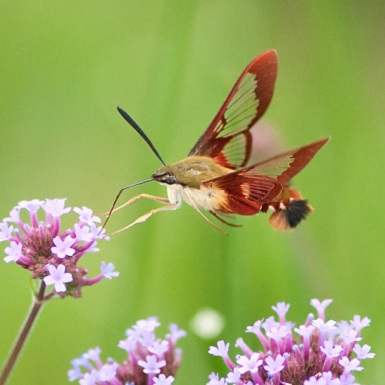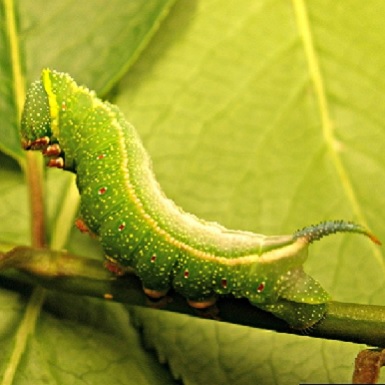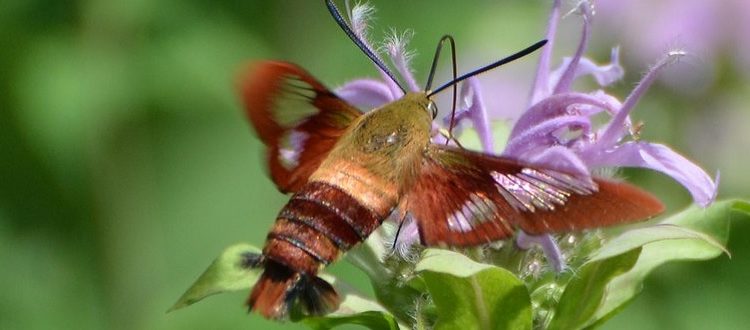CREATURE FEATURE – Hummingbird Moth
Is it a hummingbird? A butterfly? A moth?
video credit: www.rougepark.org
Have you ever seen what you think is a small hummingbird around your flowers during the day? It could be a type of moth called the hummingbird clearwing moth.
FUN FACT: Tiny hummingbird moths strongly resemble real hummingbirds. The hummingbird moth beats its wings 30 – 40 times per second in a figure eight pattern that is similar to the pattern a of a real hummingbird. (However, actual hummingbirds beat their wings 50 – 60 times per second.) The figure eight pattern made by the wings allows both hummingbirds and hummingbird moths to hover in mid-air and to fly briefly backwards.
Hummingbird moths build their cocoons on the ground within the leaf litter at the base of their host trees and shrubs. Therefore, if you are lucky enough to have an appropriate host plant (e.g. viburnum, cherry, plum) for these little guys, it is important to leave the leaf litter intact. Otherwise, you may inadvertently toss the next generation of hummingbird moths in the trash.
PHYSICAL CHARACTERISTICS
Hermaris thysbe moths are in the Sphingidae family. There are over 1,400 individual moth species in this family, and they share a confusing mix of nicknames that are often used interchangeably. These nicknames include hummingbird moth, hawkmoth, bee moth, sphinx moth, clearwing, and hornworm. This overlapping use of nicknames can lead to some confusion within casual literature regarding this moth family.
The Hemaris thysbe, the hummingbird clearwing is the specific species most commonly known as the “hummingbird” moth and the one found in the Rouge River area. This cute little guy resembles a hummingbird in looks and flight habits. He is also known to make a humming sound (with his wingbeats) that sound similar to a hummingbird. Hemaris thysbe has a fuzzy body and shares the general coloring of many hummingbirds with an olive green and rust colored back and a lighter colored abdomen. The wings have rust colored margins with clear inner sections. The clear portion of the wings is due to a loss of the tiny (colorful) scales that normally cover the wings of butterflies and moths. Adults have wingspans of 1.5 to 2.2 inches and are about half the size of a ruby-throated hummingbird.
The caterpillar of Hemaris thysbe is light green with a bluish “horn” on its terminal end and a light-colored stripe that resembles a leaf vein.


Adults drink flower nectar and possibly prefer pink and purple flowers. Favorite flowers include bee balm, verbena, and phlox as well as the flowers on their host fruit trees.
Caterpillars feed on the leaves of host trees/shrubs such as cherry, plum, hawthorn, honeysuckle, and viburnum.
If planting a tree/shrub specifically to attract these little hummers, be careful to purchase a true US native plant. There are many cultivars and European versions heavily marketed by large commercial nurseries as “good for pollinators.” Unfortunately, these plant versions may actually not have the correct pollen, nectar, sap, fragrance, etc. to be recognized or digested by our own US native bugs. Therefore, it is best to buy habitat plants from the smaller, (and local) true native plant nurseries.
HABITAT & LIFE CYCLE
Hummingbird moths are strong fliers who are capable of covering large distances. They may be found throughout the continental US and Western Canada. However, they are most common in the eastern half of the US. While the majority of moth species fly at night, Hemaris thysbe is a visible daytime flier.
It is the female hummingbird moth who must work to attract the attention of the gents. To accomplish this, she emits pheromones and, after mating, lays her eggs on the leaves of the host tree/shrub. Eggs are commonly laid on the underside of leaves to help provide protection from birds and wasps. In approximately a week’s time, a new baby caterpillar munches its way out of the egg casing. A Hemaris thysbe caterpillar will molt (shed its skin) several times as it grows over the course of about four weeks.
At maturity, the caterpillar climbs down to the ground and spins a silk cocoon in the dirt and leaf litter. The length of time for the pupa to mature inside the cocoon depends on climate and temperature. Mature moths will emerge in April and initiate the first of two summer breeding cycles. It is believed that cocoons destined to overwinter are dug into the soil and have a harder casing than cocoons intended to hatch within the same season.
TAKE ACTION
Hummingbird moths are not considered endangered at this time. However, like all insects, they are threatened by the extensive overuse of pesticides and loss of habitat. Additionally, since this species constructs cocoons within leaf litter, they are in danger from over-zealous leaf raking and lawn mowing around their host trees/shrubs. The Xerces Society for insect conservation has a campaign of “Leave the Leaves” to encourage home-owners to let fallen leaves mulch naturally into the ground to provide winter insect habitat and to restore nutrients to the ground. For additional information, please see Xerces Society
You can be a friend to the cute little moth hummers by creating natural – pesticide free – habitats of their required native plants. Help Friends of the Rouge protect our native insects and strengthen the health of our watershed.
MAIN PHOTO CREDIT: Hummingbird Moth (Hemaris thysbe) photo: Andy Reago & Chrissy McClarren CC-BY-2.0 – image cropped



